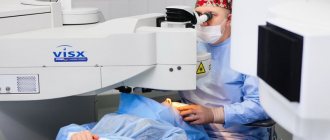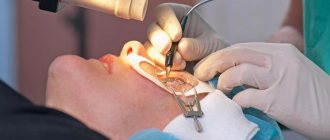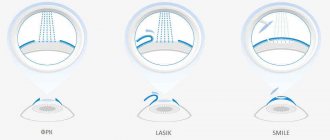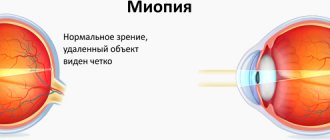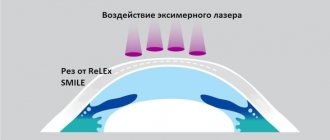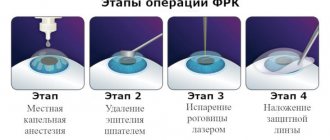Femto lasik is a vision correction surgery performed using a laser. Despite the fact that laser correction is the safest and most effective treatment method in ophthalmology, most people are afraid to decide to undergo such an operation. Moreover, fears arise due to insufficient information.
From our article you will learn what the essence of the femtolasik method is, as well as its positive and negative aspects.
Stages
The whole process can be divided into conditional stages:
- First, the patient's eyes are treated.
- Next, local anesthesia is applied (for this, anesthetic drops are usually used).
- Then the tissue flap is cut with a femtosecond laser and bent to the side. This type of laser uses an infrared beam. Pulses sent to the cornea form microbubbles, which subsequently connect and form a dissection plane.
- An excimer laser gives the cornea a new shape and changes the refractive power of the cornea by evaporating unnecessary tissue.
- After the procedure is completed, the bent flap is returned to its place.
Stages of femto lasik surgery
What is Femto LASIK correction?
Femto LASIK is currently the most advanced method of laser correction. The Super Lasik technique and its modifications assumed access to the corneal stroma by cutting the surface corneal epithelium in the form of a valve using a microkeratome. With Femto LASIK, a superficial corneal flap is formed with a femtosecond laser with pinpoint precision, which ensures extremely high safety of the operation: reducing the risk of complications, both during laser correction and in the postoperative period.
The femtosecond laser works on the principle of photochemical ablation (evaporation) of tissue. Based on the results of the preoperative examination, the surgeon uses a laser to create an accurate picture of the small, overlapping spaces just below the surface of the cornea. The laser operates at very high speeds - pulses occur at a frequency of several million times per second. Thanks to such high speed of action and precision, laser radiation is able to evaporate the finest particles of corneal stroma without generating heat and without affecting surrounding tissue.
Requirements before surgery
A few weeks before surgery, the patient must follow some rules:
- It is forbidden to wear lenses, as their use may complicate the operation.
- It is imperative to undergo an examination by an ophthalmologist and other doctors to identify chronic diseases or inflammatory diseases.
- It is forbidden to drink alcohol (two to three days before surgery).
- On the day of surgery, you cannot use cream or other cosmetics.
- It is not recommended to take medications (especially blood thinners).
How is Femto LASIK surgery performed?
- On one of the consultation days, you come for a preoperative examination and consultation with a laser ophthalmic surgeon. During the preoperative examination, based on aberrometry and keratotopography data, a personalized individual map of the cornea and its refractive surface is compiled using 1250 points. Based on this revolutionary technology, FemtoLasik laser vision correction provides optimal correction of your vision, unattainable with other Lasik techniques, contact lenses or glasses.
- After the examination, you will be given a date and time for the laser surgery.
- On the day of surgery, you will be given mild sedatives and anesthetic (pain-relieving) drops placed in your eyes. General anesthesia for FemtoLasik does not require vision correction.
- In the operating room, your eyes will be thoroughly disinfected and covered with a sterile bandage. Your eyelashes will also be further treated and a local anesthetic will be placed back into your eyes.
- The surgeon will install an eyelid speculum - a special device that prevents involuntary blinking of the eyelids and closing of the eye.
- The femtosecond laser will create a superficial corneal flap, which the surgeon will move to the side, thereby exposing the deeper layers of corneal tissue to model its new shape according to the patient's refractive error according to the topographic map obtained during the preoperative examination.
- After retracting the superficial flap of the cornea in the form of a “lid” to the side, the main stage of laser vision correction using Femto LASIK technology begins. Based on the topographic data stored in the device, the femtosecond laser evaporates areas of the cornea, forming its new refractive optical properties by changing the curvature of the corneal surface.
- Possible eye movements during surgery do not affect the final result, since the laser follows eye movements and directs the laser pulse only to the desired area of the cornea.
- At the end of the refractive stage, the surgeon thoroughly rinses the superficial corneal flap with a special solution and returns it to its place. Additional fixation of the flap is not required. Adhesion occurs due to osmotic pressure, and the healing of the corneal flap with the Femto LASIK method occurs faster than with the traditional LASIK method using a microkeratome.
- After Femto LASIK surgery, you will be given antibacterial and anti-inflammatory drops and escorted to the recovery room where you can rest. Hospitalization of the patient to a hospital with Femto correction is not required, and after 30-60 minutes you can go home.
- The entire laser treatment from arrival at the clinic for surgery to departure will take about two hours, while the duration of the Femto LASIK correction operation takes no more than 10 minutes per eye.
After Femto LASIK surgery
- During the first 24 hours after surgery, it is advisable to use sunglasses.
- The day after Femto LASIK, you must come to the clinic for a postoperative examination, during which your attending physician will prescribe antibacterial and anti-inflammatory drops for the entire rehabilitation period and draw up a personal schedule for visiting the clinic.
- As a rule, postoperative examinations after Femto LASIK vision correction are carried out the next day after surgery, after one week and after 1-2 months.
Advantages and uniqueness of Femto LASIK
- Improving the safety of laser vision correction;
- The risk of problems with the corneal flap is significantly reduced;
- Reduced risk of inflammation or infection;
- FemtoLasik is much more calmly tolerated by the patient and promotes faster vision recovery after surgery;
- The quality of postoperative vision is significantly higher than with traditional Lasik surgery, due to better laser treatment of the corneal surface;
- More stable postoperative result;
- The risks of over- or under-correction are significantly lower.
- The femtosecond laser creates a flap within 10 µm of the desired thickness, while a traditional microkeratome creates a flap within 20-40 µm;
- With Femto LASIK, the corneal flap formed using a laser is much more delicate and thinner, which does not change the biomechanical properties of the cornea and guarantees the stability of the cornea for a long time;
- At the same time, the FemtoLasik technique allows for laser vision correction with a thin cornea and correction of myopia, farsightedness and high degrees of astigmatism, for which the traditional Lasik technique is impossible;
- Temporary side effects such as dry eyes, photophobia and lacrimation are extremely rare.
Positive and negative sides
Let's consider all the advantages and disadvantages of this correction method.
pros
The positive properties include the following:
- The splitting of the cells of the cornea occurs with laser pulses in a short time, as a result of which the operation is not long in time (usually it lasts no more than ten minutes).
- Due to the short duration of the process, as well as the small diameter of the laser beam (it is only 1 micron), the surrounding tissues are not exposed to thermal radiation, which eliminates their damage.
- Femto Lasik can be performed on patients with thin corneas, since it is possible to regulate the depth of laser exposure.
- Surgery is safe and painless. During the operation, the possibility of infection of the eye is excluded (because the dissection is done in a non-contact manner).
- There are no complications after the operation, rehabilitation is quite fast. As a rule, complications arise when using mechanical instruments, because when excision with a blade, the edges of the flap are uneven. But when using a femtosecond laser, the surface of the flap is more even.
- Using this method, you can improve vision even with serious ophthalmological diseases.
Minuses
The negative points of Femto lasik are:
- This procedure is expensive.
- With the help of an impulse, the tissues of the cornea are not completely separated (the cornea and the flap remain connected by microbridges, which tear off when the flap is detached, resulting in small irregularities).
- The need for strong fixation of the eye during surgery. For this purpose, a vacuum clamp is used, which has a large negative pressure. Such pressure can lead to adverse consequences (for example, retinal detachment or rupture). To exclude the possibility of such consequences, a thorough preliminary examination of the patient is carried out, and, if necessary, laser strengthening of the retina is performed.
Femto LASIK® laser surgery
Laser vision correction using FemtoLasik technology is currently the safest, most modern and personalized laser surgery method for correcting myopia, farsightedness or astigmatism.
Femto LASIK is the most advanced excimer laser technology designed for people who cannot see without glasses or contact lenses. And if you suffer from myopia (myopia), farsightedness (hypermetropia), astigmatism or presbyopia, then FemtoLasik surgery will allow you to permanently abandon optical correction methods.
What is a femtosecond laser?
The femtosecond laser is an infrared laser operating in the ultraviolet range. A distinctive feature of the femtosecond laser is its careful treatment of corneal tissue and safety of use when performing Femto LASIK vision correction.
With Femto LASIK, the laser evaporates a thin layer of corneal tissue according to a given algorithm, thereby we can change the shape of the cornea: make the profile of the cornea flatter in cases of myopia, simulate a steeper shape of the cornea in case of farsightedness, or give the cornea the correct spherical shape in case of astigmatism.
When is Femto Lasik necessary and contraindications?
After performing a similar procedure, patients can get rid of farsightedness (up to +4 diopters), myopia (even for those with 15 diopters), astigmatism (up to 5 diopters).
There are also contraindications to performing femto lasik; as a rule, it is not recommended to perform:
- Persons under eighteen years of age, as well as citizens over 45 years of age.
- Pregnant women, as well as women during the postpartum period and lactation period.
- When diagnosing cataracts, glaucoma, retinal detachment.
- With a sharp deterioration in vision over a short period of time.
- The presence of diseases such as HIV, AIDS, cancer, arthritis, rheumatism, diabetes and others.
- With alcohol abuse.
- Complete blindness of one organ of vision.
Postoperative period
After undergoing such laser correction, patients may experience minor discomfort. It may be difficult for them to look at bright light; glare and rainbow circles may appear before their eyes; profuse lacrimation or, conversely, dry eyes may occur. To reduce such negative sensations, your doctor may recommend using special drops.
The specialist will also advise the patient about actions that should not be taken after surgery during the rehabilitation period. Patients should know what is prohibited:
- Rub your eyes.
- Use contact lenses.
- Swim in a pool, lake, or other body of water, wash your eyes with tap water to eliminate the risk of infection in your eyes.
- Visit the bathhouse, sauna.
- Drink alcohol.
- Overexert your visual organs (working at the computer, watching TV).
- Use decorative cosmetics.
- Exercise.
- Be in a smoky place.
Advantages of the FEMTO SUPER LASIK method
Laser vision correction using the FSL method is an expensive pleasure, but the patient should know that the chosen technique has many advantages:
- minimal likelihood of complications;
- high accuracy, coinciding or almost coinciding with the predicted result;
- safety and painlessness of manipulation;
- the ability to perform surgery on thin corneas;
- low morbidity;
- the ability to take into account all the individual anatomical features of the patient;
- minimum recovery time (2 hours);
- non-contact intervention;
- no increase in intraocular pressure during surgery.
Complete comfort and safety of the patient during surgery, better contrast sensitivity, absence of dryness and pain after manipulation make FSL an advanced method of laser vision correction that has no analogues.



